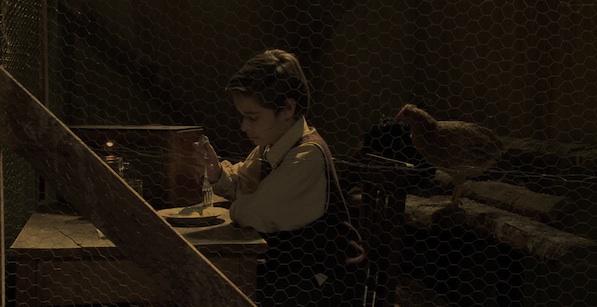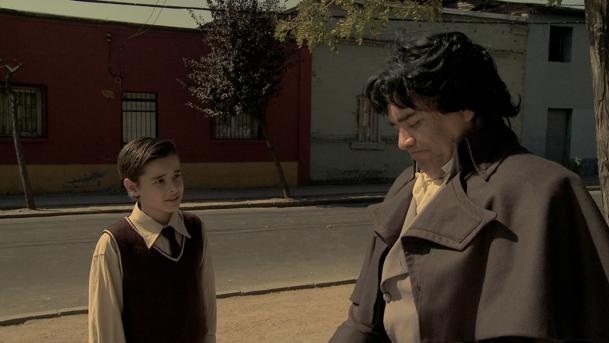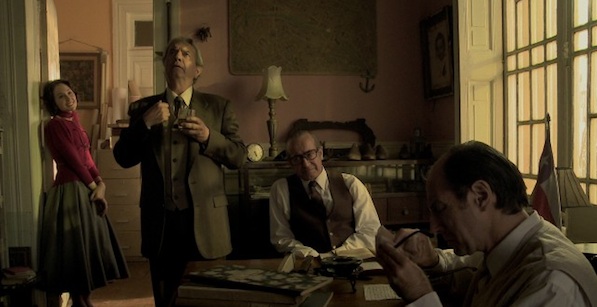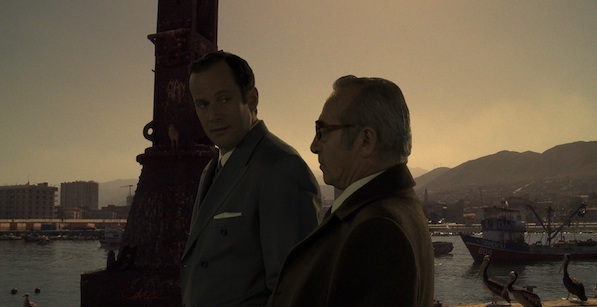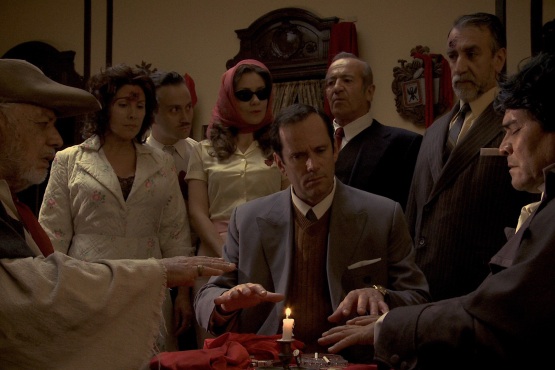I.
Some things never seem to start in the cinema of Raúl Ruiz, and some things never seem to end. His films take place in the fuzzy, indeterminate zone between finding a beginning and reaching a conclusion to the central action. That is, if you can figure what the central action is meant to be.
In La noche de enfrente/Night Across the Street (2012), Ruiz’s last completed work, the central action appears, for much of the film, to center on an old man, Celso Barra (Sergio Hernández), who is anticipating—as he has long anticipated—the moment of his own death. He believes that a hired killer is coming for him, and he patiently awaits this assassin each night, in the parlor of the boarding house where he dwells. Several different prime candidates appear, in the course of the events, who might be about to carry out this preordained act. Eventually, it is Celso himself, as a neat, well-dressed schoolboy (Santiago Figueroa), who shows up with the gun. But a final twist on this plot—just one image—suggests another scenario altogether.
But there is something else, as well: a crime, a mass murder in fact, also in the parlor of the boarding house—a line of corpses that is revealed to us in one of those off-hand visual postscripts to a scene, when the camera moves, that Ruiz loved to append wherever and whenever possible. Is this the real center of the movie, the crime to which everything else provides a scattered, obscured genealogy? Ruiz, especially in the last fifteen years or so of his career, married the generic structure of the murder-mystery (the more old-fashioned, the better) to the often grisly faits divers that filled his experience, and especially his long memory, of his homeland, Chile. Crimes, secrets, murders, bodies in pieces everywhere; so pervasive, in fact, such a mundane occurrence, that they become banal, just part of the texture of a strange, everyday life.
In a Ruiz film, whichever guiding plot you ultimately choose from the available menu of options only ends up being a cover for another logic behind the scenes—an “occult order,” he often called it, but even this was just another fictional ploy (however resonant with the myriad conspiracies of real-world events and institutions). The final, bottom level of mystery in his work—often deliberately impossible to crack—is how any one film has been generated: from which pool of elements, according to which permutational or transformative procedures? Because it is the proliferation of this game-logic—eating up everything it touches upon—that constitutes the main event, the central action, certainly in La noche de enfrente.
Ruiz designed his films like this: you dive in anywhere, find any entry-point you can, and soon (if you are alert and inquisitive) you will feel like you maybe have your hands on a key to the whole. But if you dare re-plunge in at another point, you will experience exactly the same thing, only to arrive at a different conclusion. (An excellent and handy guide to several such interpretive procedures is provided in the forthcoming book from Wallflower Press, Michael Goddard’s Impossible Cartographies: The Cinema of Raúl Ruiz.)
Let me sprinkle the opening moves of several of these journeys into the film. La noche de enfrente is a playful meditation on words and things: which comes first, which generates the other? One example among a hundred: Celso—in the discreet background of an image—has a romantic moment with the secretary from work, Laurita (Valentina Murh). As they kiss, Laurita—who spends much of her time asking for four-letter combinations in crosswords—recognizes the word she has been looking for all along, beso (kiss)…and abruptly exits the love-scene with this gift. More emphatically underlined throughout the film is the fantastical-sounding word rhododendron: it gets successively used or defined as a name (which also becomes other names: Rolo, Rodo Pedro), a horse, a plant, a brig, a fish, a “cowardly killer”.… By the end, you will not be able to remember which one of these signifieds is the “correct” one.
Ruiz often returned, in his work, to the motif of a Book of Life: a text in which everything that will happen has already been inscribed. This Book can take many semiotic forms: spiritual prophecies, popular songs, cryptic codexes, hieroglyphic picture-puzzles. (We see seated readers animated into grotesque gestures by one such literal Book in the short The Film to Come, 1997.) Sometimes, it is precisely this “legend”—stuffed with outrageous stereotypes of every kind—somehow uncovered (often unwittingly) by the characters, that pinpoints Ruiz’s own source for the ludic generation of his film. One such source here is probably autobiographical: set quite precisely in the late 1940s—if we go by the movie posters up at the local “Los Condores” cinema, and by the political chatter (‘a clean sweep!’) pre the re-election of Carlos Ibañez de Campo as President in 1952—the film swells with motifs from Ruiz’s own Chilean childhood, as his producer François Margolin has testified: pirate ships, old radios, tunes…. And here is Long John Silver (Pedro Villagra) himself, providing a clue to the film’s generative puzzle when he alludes to the immortal story (whatever it may be) of the “two brothers of the seashore, and the three guns.…”
I confess that, as a 21st-century citizen, I enjoy having a Ruiz film open on one window of my laptop, with Wikipedia ready to consult in the corner of the screen. You can discover many intriguing things this way, further possible keys: Adamov, for example, mentioned as a suicide in the dialogue. Presumably Arthur Adamov (1908-1970), whose work Professor Taranne Ruiz adapted in 1987; even just glancing at the titles of his literary works suggests a secret pool of initial elements for Ruiz’s use: The Parody, The Invasion, Ping-Pong, The Politics of Rubbish, If Summer Came Again … and he was an editor on a Surrealist magazine (of which I have never previously heard—well, there was only one issue in 1929) titled Discontinuité!
There is a specific body of writing underneath the film, as well. Apart, that is, from the character who reluctantly bears the name of “Jean Giono” (Christian Vadim)—he may or not be the writer of that name but, at any rate, has to live with the equivalence—a reminder of Ruiz’s lush adaptation of Les âmes fortes/Savage Souls (2001). “Freely inspired by the tales of Hernán del Solar,” says the credit of La noche de enfrente (not, as per the subtitle, “inspired by the novel,” although there is a 1952 book of his with this title)—a critic, novelist, essayist, poet and “creator of Chilean stories for children,” 1901-1985, whose work is (as far as I’m aware) completely untranslated into English. It is too little recognized what an original and inventive adapter of literature Ruiz was throughout his career. Adaptation always proceeded, for him, through a kind of rigorous but sideways reading, a little like how a Lacanian psychoanalyst listens in on the speech-flow of a patient: Ruiz sought to pick up the patterns, clues, obsessive motifs that may have escaped the conscious design of the writer (as he also did with the work of filmmaking students he supervised). I have not yet tried to read del Solar, so I cannot say which elements of his were drawn and redrawn in the mix of La noche de enfrente as a film: seagulls, maybe? Whores? The “cursed boarding house,” this splendid house of fiction? The pesky alarm clock of Don Celso that, at one moment in a public bar, begins flying? Beethoven going nuts, like those mythical first spectators of silent cinema, when he encounters the shadows on a movie screen—not to mention a movie that seems to be an intercut mash-up of several releases in different genres?
So, what we seek—by whatever route we can take—is less an interpretive key to than a dynamic matrix of elements: and, as Ruiz regularly proved, it does not really matter which elements you begin with (just as it hardly matters which ‘formative experiences’ or sensations make up a self or a character)—the game can proceed and whip up a storm. Although it can be a facile short-circuit to “explain” Ruiz’s films by reference to his theories (of “central conflict theory” and whatnot, as elaborated in his essays, interviews and Poetics of Cinema books), the ideal he often discussed of secondary elements (props, items of background décor, certain banal but repeated sounds or gestures) rising up, through various strategies, from the background and eventually devouring the whole film, achieves a high degree of realization in La noche de enfrente. Gestures like laughing and crying (often delivered in instant alternation). Details that are easy to miss, like the fact that in the first “back-projected screen” scene (digitally mocked-up), at a certain split-second just before it ends, people start walking and riding backward!
Ruiz also said, often, that his ultimate goal was to arrive at—to master just enough to unleash, like Jackie Chan’s Drunken Master—“specifically cinematographic emotions.” Many viewers of Ruiz (especially first-timers) find it hard to catch the emotion, and detect only the hyper-cerebral, neo-baroque game-playing, of the kind I have tried to sketch above. But it is hard to really name, label or describe the properly cinematographic emotions (neither cognitive psychology nor classical psychoanalysis will help us much here): for any Ruiz fan, La noche de enfrente is saturated with feeling, and headily so, but not only, maybe not at all, feelings associated with the melancholia of aging and sickness, or impending mortality—the biographical facts we are compelled to read into this “testament” film. Ruiz was not one for testaments; or else, like Don Celso, he was fashioning them already, from earliest childhood. Or the only true Testament is beyond us, anyhow, already written in the Book of Life. Over the final credits, we hear the raw sound-take of a scene, and Ruiz intoning “Cut!” Is this sad? He always declared that to him, “death was a working tool,” a poetics, and that every cut was a productive instance of dying….
II.
Some things never seem to start, and some things never seem to end. A refrain in the film, endlessly varied in its nominal subject, takes the form of: “It will happen tomorrow, or the day after, or maybe it has already happened.” This is the beguiling temporality of Celso’s death, extensively imagined, in a set of thought-experiment hypotheses, across the entire length of the film: it could suddenly happen, it may take a long time to happen, it may never happen—or it happened long ago, so it’s all over. The spectator waits for the thing to happen—or waits for the explanation of how it has managed to already happen, when we did not know it happened. Ruiz was fond of those passages in murder-mysteries where detectives just wait, passively (that’s about all they ever do in Ce jour-là/That Day, 2003), for signs of the truth to reveal themselves; or when they begin to declaim their baroque explanations of a suddenly, pre-emptorily “closed book.” Ruiz was equally fond—on another social/fictional register—of empty speechifying (he must have sat through a lot of it), one recited speech (or poem or song) after another: the academic-seminar version of this (off which Carl Dreyer had already scored a king-hit in the “poet’s tribute” gala in Gertrud, 1964) gets a work-out in another of his final pieces, Ballet aquatique (2011), just as it does in the closing stages of La noche de enfrente. Whatever the inspiration or the generic source, these are all modes of narrative delay: and no one could attenuate them like Ruiz.
There is a gun that is used to commit a crime, a murder, a suicide, whatever, in La noche de enfrente. Generic object. After the event has happened, the gun goes on functioning in the film; it’s not just exhausted as a prop and binned off-screen. That would not be a Ruizian economy. In fact, either this gun grows to gigantic proportions, or the characters shrink to miniscule ones. Everyone we have come to know, it seems, can reappear down the barrel of this gun: a tunnel which frames, at one end, the last glimpse of the nocturnal world (night out the back), and at the other end the blinding white light of another world, an after-life. We even glimpse some new characters, extras who look like they are grumpily off to work, jostling past Celso and the cyclist, Ugalde (Francisco Celhay); we are told that they are “the memories of the pistol, or rather the barrel.”
In the film, Don Celso also retires from his office job. This retirement is anticipated, discussed a lot. We wait and wait (for 67 minutes), thinking it may never happen (at least not on-screen), but we are eventually rewarded with a farewell dinner (perhaps Ruiz was remembering Edward G. Robinson at the start of Fritz Lang’s Scarlet Street, 1944), in a superb five-and-half-minute sequence-shot which is an Ophulsian highlight of Ruiz’s cinema. Retirement is, in Ruiz’s imagination, a kind of “little death,” a prefiguration or metaphor for dying—a full stop that brutally divides active-working life from inactive-leisure years; it’s also like this in reality, for many people around the world, who find themselves rudely superannuated out the door at age sixty or sixty-five. But hang on! When precisely does the demarcation-point of retirement happen here? Celso, we are told, retired long ago; even when he was working, he had retired—he mastered the art of doing nothing (a wonderful joke about bureaucratic office behavior). “He never stopped leaving us.” Now, on the eve of retirement, he rehearses enigmatic hand gestures while sitting at his desk; he is Bartleby the Scrivener, the “immobile voyager” beloved of Continental Philosophy, with “many busy years of doing nothing ahead of him.”
Endings: Ruiz’s films regularly, but deliberately, behave like those interminable Peter Jackson blockbusters that multiply their endings, or seem to be unable to satisfactorily conclude anywhere—always another loose end to tie up. Paul Hammond noted this tendency in Ruiz’s work as far back as 1983, in City of Pirates: If Ruiz’s film palls in its compulsive retreading of trod ground, in its insistent miracle-working, it is because such desiring fictions are by definition interminable, and autonomous.” (Read Hammond on City of Pirates). There is a keen moment in the formal process of every “desiring fiction” to which Ruiz was especially attuned: what Frank Kermode described in literature as the “sense of an ending,” that first sign which speaks to our conscious or unconscious mind—via an image, a music cue, a change of rhythm—that the end is nigh, that everything is summing up and winding down. Wanna be endin’ somethin’.
When Ruiz begins the fold that announces the sense of an imminent ending—when something returns that we have seen before, now as some kind of encapsulation or epiphany—we experience one of those specifically cinematographic emotions he so dearly sought. But then he folds and re-folds, finding different points (all cleverly established earlier) on which to end this “retreading of trod ground.” So, beginning about twenty minutes before the final black and the final sound of “Cut!,” come the endings, announcing themselves with gravity or flair: the marbles; the empty classroom; another radio broadcast; the helicopter shots of the coast from the opening credits; the boarding house—opened up like a labyrinth, from one adjacent room to the next, The Shining-style; and the alarm clock ringing, ringing, like the telephone in Once Upon a Time in America….
What happens in that fuzzy zone between starting and ending, what fills out Ruiz’s films? La noche de enfrente offers an elegant demonstration of the sort of multi-level construction that quickly slips, slides, and loses its schematism. The first batch of scenes take us, in a smooth, clear way, through specific sites that are going to recur in the film: classroom, street (with back-projection), office, bar … plus a flashback, of sorts: to the young Celso, chatting with Long John Silver; later, his interlocutor is Beethoven (Sergio Schmied). The introduction of the adult Celso’s narrating voice cues another structuring/triggering device: his radio broadcasts. Soon we will be floating freely between past and present, child and adult; eventually, our hero, in his after-life, will come upon Long John, Beethoven and Giono at a table: “Who do they think they are? I invented them. Now they do as they please.” The same goes for himself as a child, who slowly turns from remembered object to creating subject: as always in Ruiz, we reach the properly figural plateau where we can no longer tell whether the adult self is projecting backwards, or the child self is projecting forwards. We meet them both, as equals, in the middle of this psychic space—a space which, for this filmmaker, has precious little to do with purely individual, subjective memory. And this brings us to the vexed question of time.
“Night Across the Street” is an attempt to capture in English translation the strangeness of the Spanish title, which does not mean “the coming night” (as it is subtitled during some dialogue)—it is not something up ahead in time—but something more like a physical block of materiality, right in front of you. As he proclaimed at the time of making his Proust adaptation, Time Regained (1999), Ruiz was deeply interested in scientific theories of time as a dimension, more than in its standard definitions as either duration (the Henri Bergson tradition) or as personal recollection (the couplet of “time and memory” so beloved of film studies of Resnais, Marker, etc). La noche de enfrente is devoted to physical images, embodiments, concretizations of time along such solid, dimensional lines: ships in bottles, marbles on the shore.…
Closing the eyes is another of those “little deaths” we see often in Ruiz’s films. His characters are advised or directed to shut their eyes—not to sleep, but to be productive, active: to dream, learn, listen, imagine. They frequently move and carry out their tasks in an eyes-wide-shut trance (in his tribute video Responso [2004], Ruiz pictured even the legendary film festival director Huub Baals as constantly in this state, at his work desk). In La noche de enfrente, Giono’s language classes proceed with all students (including the old Don Celso) sitting, alert, with their eyes closed, answering no question which the teacher directs their way; and Long John Silver, likewise, guides the young Celso to shut his eyes in order to see a ship out on the wild seas. But this clairvoyant kid cannot be fooled: “That ship’s from a film. I saw it last Sunday.”

